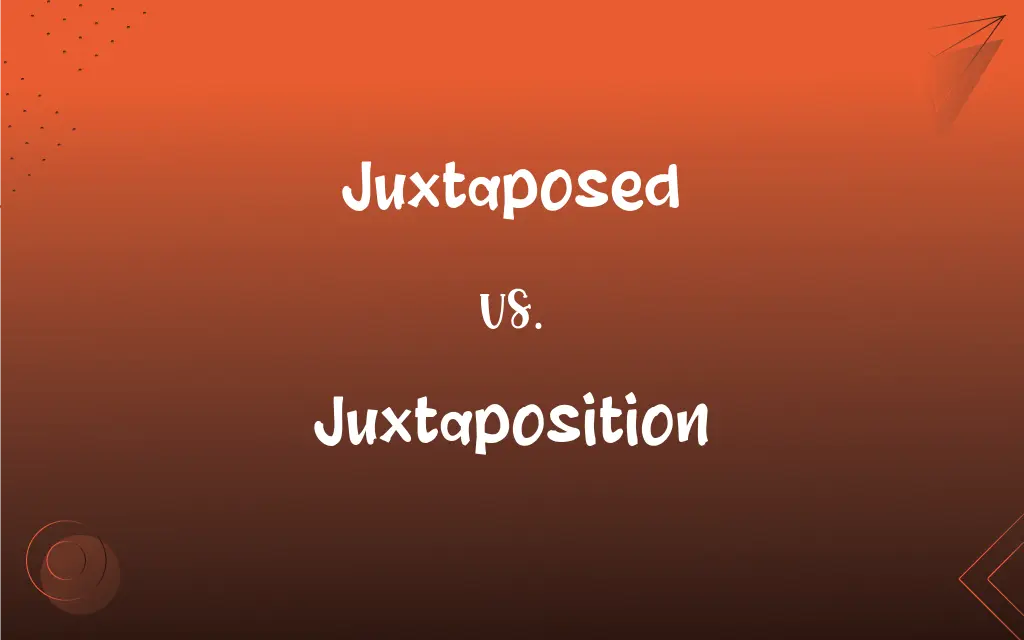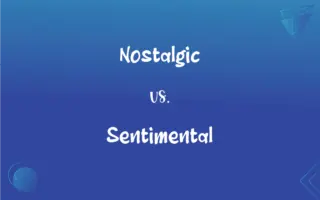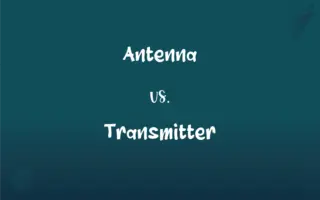Juxtaposed vs. Juxtaposition: What's the Difference?
Edited by Harlon Moss || By Janet White || Updated on September 27, 2023
"Juxtaposed" is the act of placing things side by side, while "juxtaposition" is the state or position of being placed close together or side by side.

Key Differences
"Juxtaposed" refers to the actual action or process of placing things next to each other for contrasting effect. On the contrary, "juxtaposition" signifies the resultant state or condition when two things are placed side by side.
When two elements are "juxtaposed", they are set alongside each other, often to create a specific effect or to highlight their differences or similarities. "Juxtaposition", however, is the term that describes this arrangement or the actual concept of placing things close together for contrast.
For instance, in art, colors might be "juxtaposed" to enhance their individual vibrancy. The "juxtaposition" of those colors can then lead to a more striking visual effect.
It's worth noting that "juxtaposed" often implies a deliberate action. For example, a photographer might have "juxtaposed" two subjects in a frame. On the other hand, "juxtaposition" can be used to discuss the outcome or observation, like the "juxtaposition" of old and new architecture in a city.
Grammatically, "juxtaposed" is a verb (often seen in its past tense form) or an adjective, while "juxtaposition" is a noun. The former focuses on the act, while the latter emphasizes the result or state of that action.
ADVERTISEMENT
Comparison Chart
Part of Speech
Verb/Adjective
Noun
Focus
Action/Process
Resultant state/condition
Usage
Refers to the act of placing side by side
Describes the arrangement of things placed side by side
Implies
Deliberate action
Outcome or observation
Application
Can be applied to the action or the result
Primarily describes the result
ADVERTISEMENT
Juxtaposed and Juxtaposition Definitions
Juxtaposed
Placed side by side for contrast.
The modern art was juxtaposed with classical sculptures.
Juxtaposition
The state of being adjacent or contiguous.
The juxtaposition of these two cultures offers an intriguing mix of traditions.
Juxtaposed
Aligned next to each other for emphasis.
The contrasting colors were juxtaposed for a vivid effect.
Juxtaposition
The act or placement of two things next to each other.
The juxtaposition of the comedic and tragic scenes added depth to the play.
Juxtaposed
Set alongside one another.
The old and new buildings were juxtaposed in the city center.
Juxtaposition
The placement of things side by side for contrast.
The juxtaposition of dark and light creates depth in the painting.
Juxtaposed
Positioned close together.
The two actors were juxtaposed in the film's poster.
Juxtaposition
Positioning elements closely for effect.
The juxtaposition in the poem emphasized the poet's emotional conflict.
Juxtaposed
Located adjacently for comparison.
The different fabrics were juxtaposed to highlight their textures.
Juxtaposition
A side-by-side arrangement for comparison.
The juxtaposition of old photos with new ones showed the city's transformation.
Juxtaposed
To place side by side, especially for comparison or contrast.
Juxtaposition
The act or an instance of juxtaposing or the state of being juxtaposed.
Juxtaposed
Placed side by side often for comparison or contrast.
Juxtaposed pictures
Juxtaposition
The nearness of objects with little or no delimiter.
Juxtaposed
Simple past tense and past participle of juxtapose
Juxtaposition
(grammar) An absence of linking elements in a group of words that are listed together.
Example: mother father instead of mother and father
Juxtaposed
Placed side by side often for comparison;
Juxtaposed pictures
Juxtaposition
(mathematics) An absence of operators in an expression.
Using juxtaposition for multiplication saves space when writing longer expressions. collapses to .
Juxtaposition
The extra emphasis given to a comparison when the contrasted objects are close together.
There was a poignant juxtaposition between the boys laughing in the street and the girl crying on the balcony above.
Juxtaposition
(arts) Two or more contrasting sounds, colours, styles etc. placed together for stylistic effect.
The juxtaposition of the bright yellows on the dark background made the painting appear three dimensional.
Juxtaposition
(rhetoric) The close placement of two ideas to imply a link that may not exist.
Example: In 1965 the government was elected; in 1965 the economy took a dive.
Juxtaposition
To place in juxtaposition.
Juxtaposition
A placing or being placed in nearness or contiguity, or side by side; as, a juxtaposition of words.
Parts that are united by a a mere juxtaposition.
Juxtaposition is a very unsafe criterion of continuity.
Juxtaposition
The act of positioning close together (or side by side);
It is the result of the juxtaposition of contrasting colors
Juxtaposition
A side-by-side position
FAQs
What does "juxtaposed" mean?
"Juxtaposed" refers to things placed side by side, often for contrast or comparison.
Is "juxtaposed" an adjective or a verb?
"Juxtaposed" can be both an adjective and a verb (often in its past tense form).
Can "juxtaposition" be used in everyday conversations?
Yes, "juxtaposition" can describe any scenario where things are placed side by side, whether in art, discussions, or daily observations.
How is "juxtaposition" used in a sentence?
"Juxtaposition" describes the state of two things being placed close together, as in "The juxtaposition of the two paintings highlighted their differences."
Can "juxtaposition" refer to abstract concepts?
Yes, concepts, ideas, or emotions can also be in juxtaposition, not just physical objects.
What's the purpose of juxtaposing elements?
Juxtaposing elements can highlight their differences, similarities, or create a specific effect or emphasis.
What might be a visual example of "juxtaposed" items?
A modern skyscraper next to a historical building is an example of "juxtaposed" architectural styles.
How does "juxtaposed" relate to "contrast"?
While both can involve differences, "juxtaposed" refers to the act of placing things side by side, whereas "contrast" emphasizes the difference itself.
Is "juxtaposition" a literary device?
Yes, writers often use juxtaposition to develop characters, set mood, or emphasize differences in a story.
About Author
Written by
Janet WhiteJanet White has been an esteemed writer and blogger for Difference Wiki. Holding a Master's degree in Science and Medical Journalism from the prestigious Boston University, she has consistently demonstrated her expertise and passion for her field. When she's not immersed in her work, Janet relishes her time exercising, delving into a good book, and cherishing moments with friends and family.
Edited by
Harlon MossHarlon is a seasoned quality moderator and accomplished content writer for Difference Wiki. An alumnus of the prestigious University of California, he earned his degree in Computer Science. Leveraging his academic background, Harlon brings a meticulous and informed perspective to his work, ensuring content accuracy and excellence.































































